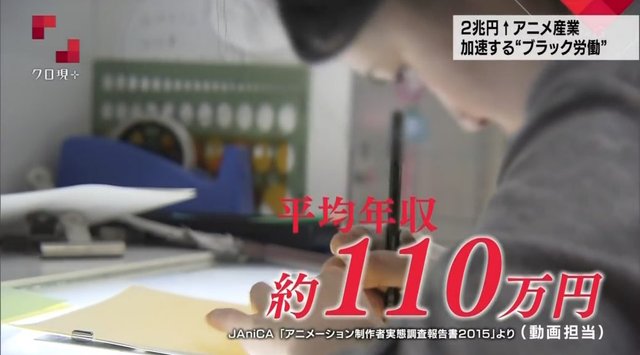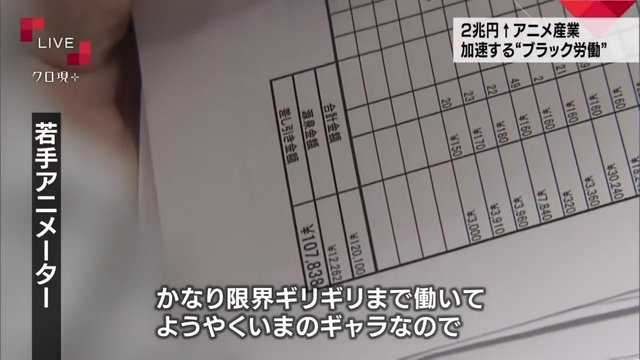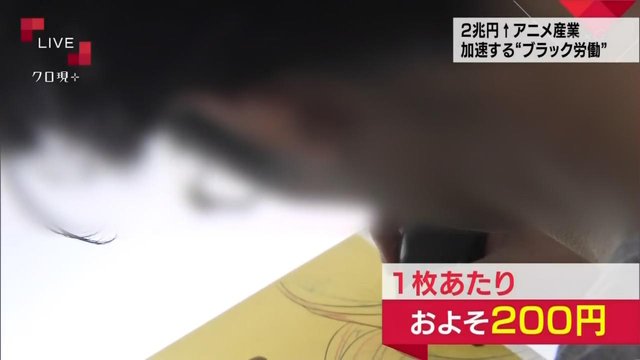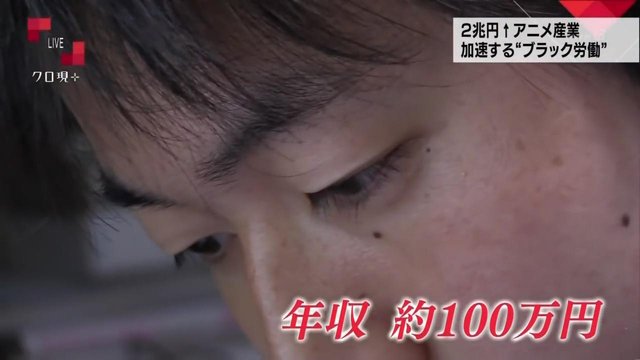
The Struggle Of Anime's Novice Creators
We often highlight interesting animators and directors who just irrupted into anime and are finding success at a young age, but some times we have to focus on the struggle of less fortunate individuals instead. At a time where anime needs the help of new creators more than ever, the working conditions for youngsters who want to join the industry have grown to be so poor that we’re stuck with very high attrition rates and miserable standards. It’s important that we examine the specifics, both the data and its context, as well as how different studios address this problem.
Although it’s common knowledge that working conditions in the anime industry leave a lot to be desired, the specifics have always been a bit vague. Fans who truly are invested in these matters could do more research on the situation and its context, but the blame actually lies elsewhere: this is a very deliberate choice by production companies to begin with. Recruitment pages almost never give actual salaries, freelance artists are rarely in a comfortable position to publicly display their intended rates, and even contracted staff essentially have to keep specific scheduling and remuneration discussions private. Concrete improvements are harder to achieve if we aren’t able to detail the problems to begin with, hence why organizations that aim to sanitize the industry hold so many anonymous polls to give estimates of its state that are as representative as possible. JANiCA’s honestly depressing data tends to make the rounds whenever they compile new information, but this time I’d like to address something more specific: the conditions for newcomers to the anime industry, especially animators training as in-betweeners.

The Struggle Of Anime's Novice Creators
To the surprise of no one, young people are the collective being paid the least, because lack of experience just happens to be the perfect excuse to make poor wages even worse. Organizations like the NPO Animator Supporters attempt to alleviate the problem with initiatives like the Animator Dormitory Project, a wonderful effort to offer affordable housing to some artists who are only just starting out. Through AEYAC they also collect extensive data about the working conditions of young anime creators, making them an invaluable resource in this field. But rather than simply dropping numbers, I believe that contextualizing everything is what’s most important here to avoid unfortunate misunderstandings; just last year it was studio Ghibli of all companies that caught some flak online for only paying 200,000 JPY a month to their animators… which obviously wasn’t the full story. In his appearance in an NHK feature very critical with the state of the industry, director Yasuhiro Irie actually had to defend them by noting that people overseas had failed to realize that the offer was aimed and rookie animators to be trained in the project, that the usual nightmarish working schedules weren’t a factor, and that the fact that they were salaried employees already put them in a better position than most. Now this doesn’t invalidate the idea that animation should be better paid across the board, but if we’re not careful we can end up criticizing the studios that treat their trainees the best.
Let’s return to that AEYAC data, very nicely summed up in this Huffington Post Japan piece, to give you a better understanding of the situation as a whole. For starters, it’s worth noting that only 7.2% of the young animators they approached were regular employees, while 73.8% of them were working as freelancers – 68.6% located at the studios themselves, and 5.2% working from their own homes… which let’s not forget, tend to be their parent’s, relatives, or friend’s homes as they can rarely afford rent. The most common working day is 10~13 hours, with 88.2% of new animators working over 200 hours a month. And when it comes to the remuneration, things only get worse. JANiCA noted that the average income for in-betweeners is 92,500 JPY a month, and this report in particular brings attention to how 69.3% of youngsters make at most 120,000 JPY a month. And beyond how little money they make, there are glaring issues with the payment system itself. The earnings of 84.85% of young animators depend either fully or very sizably on how much they draw, as only 13.17% have a fixed salary and a negligible 0.69% is remunerated according to hourly rates. Though it’s not really mentioned there, almost all in-betweeners are paid per drawing, at ridiculously low rates like 200~400 JPY each. Now keep in mind that while all this data sounds terrible it’s even worse when you’re only just starting, as indicated by the data point regarding the initial salary: only 0.7% of the polled young animators earned over 180,000 JPY in their first venture into the anime industry, as most of them received under 60,000 JPY, often going as low as under 20,000 JPY in their first month of work. Now if we return to Ghibli’s offer of 200,000 JPY a month with much better conditions for the trainees who’ll learn under genuine legends, you’ll understand why even the most critical industry voices came to their defense. While we should always strive for better conditions, the context in this case really changes everything. Fans were outraged at an iconic studio paying seemingly very little, without realizing that it was actually a respectable effort to nurture new talent – something that’s not just a positive change of pace for this industry, but for a world where ridiculous unpaid internships are common.

The Struggle Of Anime's Novice Creators
But leaving an exception like Ghibli aside, how do most anime studios fare in this regard? As you might imagine, very poorly, otherwise the previously mentioned data would be quite different. There’s a tendency among fans to assume that the big names they perceive to make the strongest, most high-profile work would have better working conditions, but that’s not necessarily the case. The likes of Madhouse don’t even offer a real training period and leave all remuneration up to how much they animate, which is something experienced animators can often get away with but that puts a lot of pressure on people who are still learning. In the same camp of fully output-dependent wages we find studios like Trigger – even in their new location that should raise more digital animators – and A-1, which masks the fact that their newcomers rely almost entirely on commissions by pointing out that there’s an insulting salary up to 30,000 JPY a month with the possibility of bonuses. And speaking of being intentionally cryptic, fan favorite studio SHAFT didn’t even detail the type of contract they offered during their last animator recruitment drive, because certain prospects aren’t very attractive. Powerhouses like BONES value training young animators more and ensure that the trainees will at least receive 80,000 JPY a month independently of their output during their first year of genuine mentorship, while a commendable example of in-house organization like ufotable only goes up to 50,000 JPY as that bare minimum, though with the promise to upgrade their contracts after a couple of years if their work is satisfactory. Obviously these are still far from good, but it comes closer to something that could be considered a minimum salary for the rookies they intend to raise, plus whichever quantity they earn in commissions based off their workload.
Even the better examples tend to come with its share of caveats. There was an understandable storm when people found out P.A. Works’ measure to start charging young animators rent for their desk if they didn’t pass the key animation exam fast enough, but the studio’s recent attempts to nurture talent and their plans to switch the hiring model to full-time contracts for all newcomers starting in 2019 are undeniably positive developments that should really make them one of the better workplaces in this industry. Private reports we’ve received are hopeful, and projects like SayoAsa are smartly geared towards making their young animators learn from industry stars, so they seem to be in the right path. It’s also worth noting that some small studios like Science Saru and Colorido rightfully pride themselves in approaching anime creation in a much healthier way, having created spaces that are more sustainable due to their small size and digitalization of production. Sadly, the shortcomings of companies like that are very obvious: even if they treat their employees as well as humanly possible, small crews given large projects end up outsourcing a big amount of work, and there’s no way to ensure that the subcontracted staff doing most of the work will also be treated in similar fashion. And when it comes to dealing with new artists, which is the theme here, it’s obvious that they don’t even have much room for them to begin with. As handy as that would be, simply going smaller won’t magically solve the problem.

The Struggle Of Anime's Novice Creators
So what is the solution then, besides the obvious fact that salaries need to be increased dramatically and working hours halved? Mirroring the moves of the most successful studios seems like a good option, but obviously it’s not so simple as that either. Toei Animation has the highest entry point out of all major 2D anime studios, as their base salary of 226,000 JPY (with housing aid already included) applies to the animation trainees. They get to start off at a reasonable level and then have room to move up, which means that if they’re willing to put up with the undeniably hectic production the studio is known for, it’s financially sensible to stick with Toei. But since they’re an order of magnitude bigger than most of its peers, attached to a veritable multimedia empire, and have a union that was harshly fought for, we can’t really expect standard anime production companies to follow their path. In this regard, Kyoto Animation has been setting the gold standard for years, as they’ve achieved the best working environment around without growing impossibly large. Their animator training course, which many of their creators in multiple fields have attended, is only the first step for a studio that offers one year of training as animator or painter at 202,000 JPY per month plus extras if more overtime than allocated ends up happening, and very sizable improvements at immediate reach. The usual benefits like travel expenses are accompanied by up to 50,000 JPY of monthly funds to improve one’s abilities (thus including expensive animation tools), extended maternity+childcare support, and the enforcement of rules like at least two days with no overtime whatsoever even at the busiest of times. All things considered and according to the creators who’ve been both at the company and outside, the attitude makes them the least painful place to work at in this inherently stressful line of work. And while spreading this model is easier said than done, as of late some adventurous studios have been trying. Even more passive benefits like the fact that rent is about 35% cheaper in Kyoto than in Tokyo, where almost every single studio is located, are being emulated as companies like Kinema Citrus and White Fox have founded training subsidiaries in even cheaper locations; of course moving to a rural zone is already a bit of a sacrifice, but the youngsters who work at studios like Gift-o-animation and White Fox Izukogen undoubtedly lead healthier lives than most of their peers. Their efforts might take years to make a difference on a bigger scale, but it’s nice to see that some studios are willing to go beyond expressing how sad they are that they can’t treat their staff better.
Given enough time and with the right planning, these attempts to improve working conditions end up reshaping entire studios. If we return to the KyoAni example, their recent site update confirmed to which extent that’s true by noting that the average age at the studio is noticeably below industry standards at only 32, and that their staff tends to stick with them for a decade – a consequence of the endless stream of new talent either leaving after their formative process attracted by the freelance life, or just staying at a comfortable space for an indefinite amount of time. Even though I’ve pointed out just how harsh the situation is for up-and-coming creators, we know it is possible to create a space that’s not just healthier but particularly attractive to youngsters. And that’s not just a nice goal to achieve, it’s something anime needs; with the current level of output, anime desperately needs more creators, and yet it’s making the first steps into this world harsher than ever, managing to be both inhumane and straight up suicidal at the same time. We’ve spoken with both young creatives who vocally complain about their income and those who believe that once you’ve accepted a deal by your own choice you have to tough it up, animators in exceptionally stable environments and some who persevered in the freelance jungle to the point where they now receive better offers. The anime industry isn’t homogeneous and there’s no single formula of success, which is why it’s good to keep in mind that even some of the studios listed among the negative cases earlier have proven to be the right environment for certain artists. However, what essentially everyone involved in the process of making anime agree about is that improvements aren’t so much wanted but required, and that making the industry much more welcoming to rookies should be a high priority, because anime needs this infusion of new blood.
I’m aware that as a fan this is a complicated issue to contribute to, since besides a few isolated crowdfunding campaigns it feels like there’s no way to intervene. But the least we can do is to keep on regularly talking about these things, because the increase of public and governmental interest in all these issues is reportedly bothering the kind of people who might have it in their powers to start changing things.
Posted from my blog with SteemPress : https://sotaku.com/the-struggle-of-animes-novice-creators/
Hi! I am a robot. I just upvoted you! I found similar content that readers might be interested in:
https://blog.sakugabooru.com/2018/03/07/the-struggle-of-animes-novice-creators/
Downvoting a post can decrease pending rewards and make it less visible. Common reasons:
Submit
#peing #質問箱 peing.net/ja/qs/23376278 https://t.co/EE2pRoeBhN
Disclaimer: I am just a bot trying to be helpful.
Downvoting a post can decrease pending rewards and make it less visible. Common reasons:
Submit